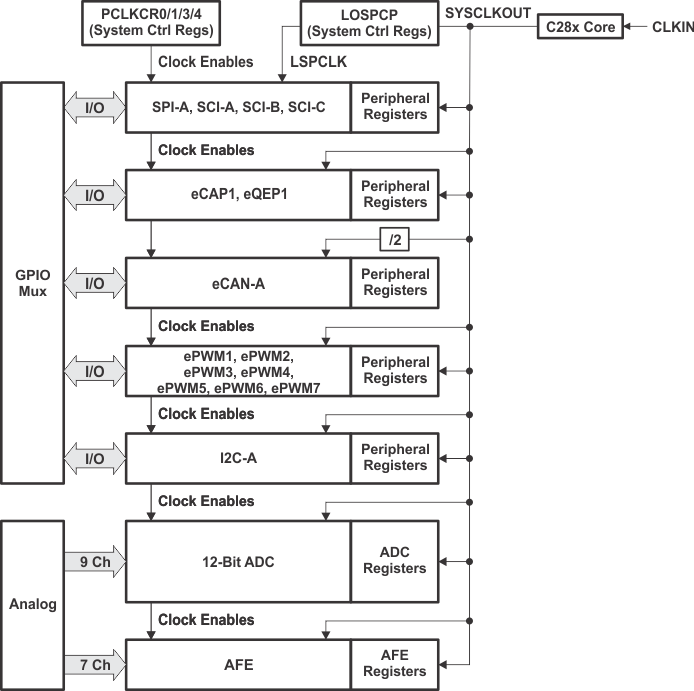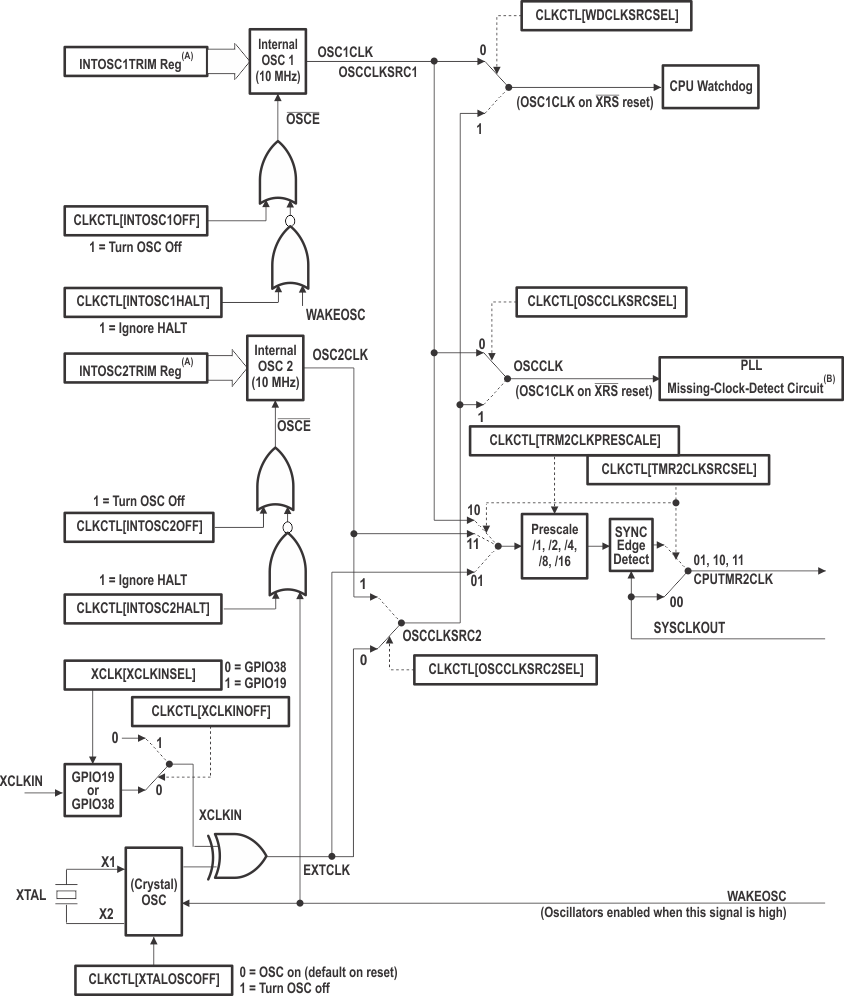SPRS797F November 2012 – September 2021 TMS320F28050 , TMS320F28051 , TMS320F28052 , TMS320F28052F , TMS320F28052M , TMS320F28053 , TMS320F28054 , TMS320F28054F , TMS320F28054M , TMS320F28055
PRODUCTION DATA
- 1 Features
- 2 Applications
- 3 Description
- 4 Revision History
- 5 Device Comparison
- 6 Terminal Configuration and Functions
-
7 Specifications
- 7.1 Absolute Maximum Ratings
- 7.2 ESD Ratings – Commercial
- 7.3 ESD Ratings – Automotive
- 7.4 Recommended Operating Conditions
- 7.5 Power Consumption Summary
- 7.6 Electrical Characteristics
- 7.7 Thermal Resistance Characteristics for PN Package
- 7.8 Thermal Design Considerations
- 7.9 JTAG Debug Probe Connection Without Signal Buffering for the MCU
- 7.10 Parameter Information
- 7.11 Test Load Circuit
- 7.12 Power Sequencing
- 7.13 Clock Specifications
- 7.14 Flash Timing
-
8 Detailed Description
- 8.1
Overview
- 8.1.1 CPU
- 8.1.2 Control Law Accelerator
- 8.1.3 Memory Bus (Harvard Bus Architecture)
- 8.1.4 Peripheral Bus
- 8.1.5 Real-Time JTAG and Analysis
- 8.1.6 Flash
- 8.1.7 M0, M1 SARAMs
- 8.1.8 L0 SARAM, and L1, L2, and L3 DPSARAMs
- 8.1.9 Boot ROM
- 8.1.10 Security
- 8.1.11 Peripheral Interrupt Expansion Block
- 8.1.12 External Interrupts (XINT1 to XINT3)
- 8.1.13 Internal Zero-Pin Oscillators, Oscillator, and PLL
- 8.1.14 Watchdog
- 8.1.15 Peripheral Clocking
- 8.1.16 Low-power Modes
- 8.1.17 Peripheral Frames 0, 1, 2, 3 (PFn)
- 8.1.18 General-Purpose Input/Output Multiplexer
- 8.1.19 32-Bit CPU-Timers (0, 1, 2)
- 8.1.20 Control Peripherals
- 8.1.21 Serial Port Peripherals
- 8.2 Memory Maps
- 8.3 Register Map
- 8.4 Device Emulation Registers
- 8.5 VREG, BOR, POR
- 8.6 System Control
- 8.7 Low-power Modes Block
- 8.8 Interrupts
- 8.9
Peripherals
- 8.9.1 Control Law Accelerator
- 8.9.2
Analog Block
- 8.9.2.1
Analog-to-Digital Converter
- 8.9.2.1.1 ADC Device-Specific Information
- 8.9.2.1.2 ADC Electrical Data/Timing
- 8.9.2.2 Analog Front End
- 8.9.2.1
Analog-to-Digital Converter
- 8.9.3 Detailed Descriptions
- 8.9.4 Serial Peripheral Interface
- 8.9.5 Serial Communications Interface
- 8.9.6 Enhanced Controller Area Network
- 8.9.7 Inter-Integrated Circuit
- 8.9.8 Enhanced Pulse Width Modulator
- 8.9.9 Enhanced Capture Module
- 8.9.10 Enhanced Quadrature Encoder Pulse
- 8.9.11 JTAG Port
- 8.9.12 General-Purpose Input/Output
- 8.1
Overview
- 9 Applications, Implementation, and Layout
- 10Device and Documentation Support
- 11Mechanical, Packaging, and Orderable Information
Package Options
Mechanical Data (Package|Pins)
- PN|80
Thermal pad, mechanical data (Package|Pins)
Orderable Information
8.6 System Control
This section describes the oscillator and clocking mechanisms, the watchdog function and the low power modes. Table 8-17 lists the PLL, clocking, watchdog, and low-power mode registers.
Table 8-17 PLL, Clocking, Watchdog, and Low-Power Mode Registers
| NAME | ADDRESS | SIZE (×16) | DESCRIPTION(1) |
|---|---|---|---|
| BORCFG | 0x00 0985 | 1 | BOR Configuration register |
| XCLK | 0x00 7010 | 1 | XCLKOUT Control |
| PLLSTS | 0x00 7011 | 1 | PLL Status register |
| CLKCTL | 0x00 7012 | 1 | Clock Control register |
| PLLLOCKPRD | 0x00 7013 | 1 | PLL Lock Period |
| INTOSC1TRIM | 0x00 7014 | 1 | Internal Oscillator 1 Trim register |
| INTOSC2TRIM | 0x00 7016 | 1 | Internal Oscillator 2 Trim register |
| LOSPCP | 0x00 701B | 1 | Low-Speed Peripheral Clock Prescaler register |
| PCLKCR0 | 0x00 701C | 1 | Peripheral Clock Control Register 0 |
| PCLKCR1 | 0x00 701D | 1 | Peripheral Clock Control Register 1 |
| LPMCR0 | 0x00 701E | 1 | Low Power Mode Control Register 0 |
| PCLKCR3 | 0x00 7020 | 1 | Peripheral Clock Control Register 3 |
| PLLCR | 0x00 7021 | 1 | PLL Control register |
| SCSR | 0x00 7022 | 1 | System Control and Status register |
| WDCNTR | 0x00 7023 | 1 | Watchdog Counter register |
| PCLKCR4 | 0x00 7024 | 1 | Peripheral Clock Control Register 4 |
| WDKEY | 0x00 7025 | 1 | Watchdog Reset Key register |
| WDCR | 0x00 7029 | 1 | Watchdog Control register |
(1) All registers in this table are EALLOW protected.
Figure 8-6 shows the various clock domains that are discussed. Figure 8-7 shows the various clock sources (both internal and external) that can provide a clock for device operation.

A. CLKIN is the clock into the CPU. CLKIN is passed out of the CPU as SYSCLKOUT (that is, CLKIN is the same frequency as SYSCLKOUT).
Figure 8-6 Clock and Reset Domains
A. Register loaded from TI OTP-based calibration function.
B. See Section 8.6.4 for details on missing clock detection.
Figure 8-7 Clock Tree